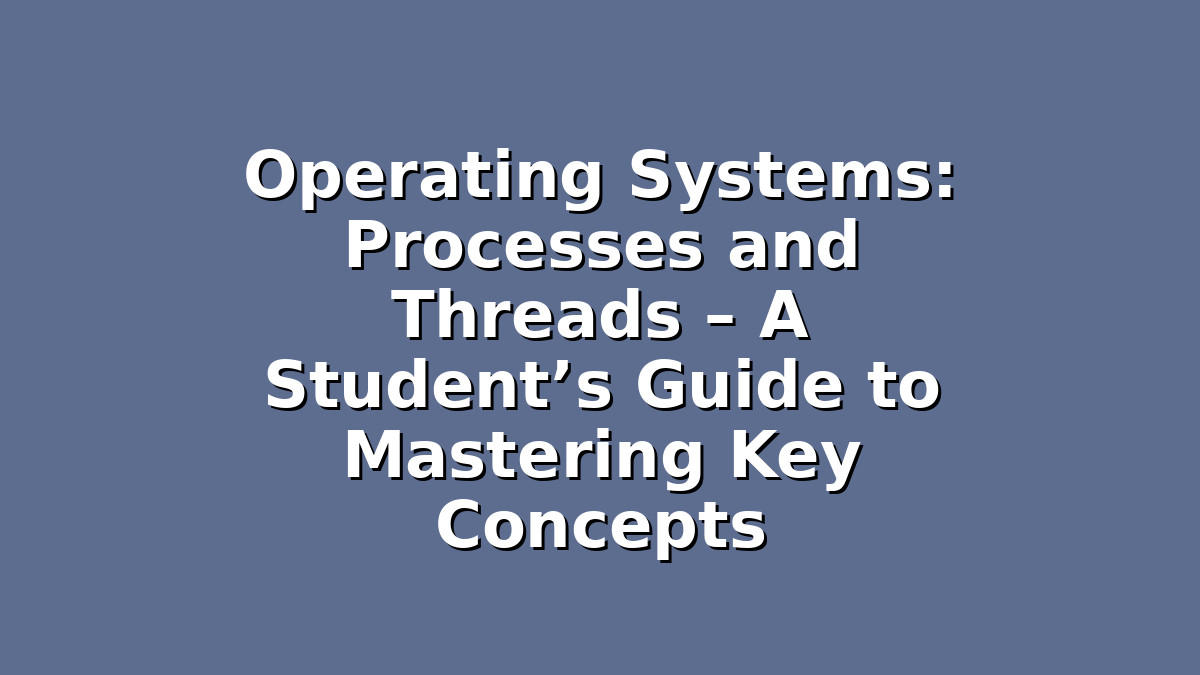When preparing for exams in computer science, especially operating systems, understanding processes and threads is crucial. These concepts form the backbone of how modern computers execute programs efficiently and manage multiple tasks simultaneously. If you’re a student looking to strengthen your grasp on these topics, this guide will help you break down complex ideas, provide effective study strategies, and boost your confidence as you prepare for your exams.
—
Introduction
Operating systems (OS) are essential software that manage computer hardware and software resources. Two fundamental concepts in OS are processes and threads, which deal with executing programs and tasks. A process is essentially a program in execution, while threads are smaller units of execution within processes. Grasping the difference between these and understanding how they work will help you solve exam questions, write better code, and appreciate the inner workings of your computer.
This article will explore processes and threads in detail, provide practical study tips, and show you how to approach these topics effectively to maximize your exam performance.
—
1. Understanding Processes: The Basics and Beyond
A process can be thought of as a running instance of a program. When you launch an application, the OS creates a process for it. Each process has its own memory space, code, data, and system resources.
Key Concepts to Learn:
– Process States: Know the different states like new, ready, running, waiting, and terminated. Visual aids like state transition diagrams can be very helpful.
– Process Control Block (PCB): This is the data structure used by the OS to store information about a process, such as process ID, program counter, registers, and memory limits.
– Process Scheduling: Understand how the OS allocates CPU time to processes using scheduling algorithms like First-Come-First-Serve (FCFS), Round-Robin, and Priority Scheduling.
Study Tips:
– Use Diagrams: Draw the life cycle of a process yourself. Creating visual aids helps commit states and transitions to memory.
– Summarize Definitions: Write down definitions of each state and scheduling algorithm in your own words.
– Practice Questions: Solve previous years’ exam questions specifically on process management to familiarize yourself with how questions are framed.
– Group Study: Discuss process states and scheduling algorithms with peers. Teaching concepts to others is one of the best ways to retain information.
—
2. Deep Dive into Threads: What Makes Them Special?
While a process is a heavyweight entity with its own resources, a thread is a lightweight unit of execution within a process. Multiple threads can run concurrently, sharing the process’s resources but executing different tasks.
Key Concepts to Learn:
– Difference between Processes and Threads: Understand that processes are independent with separate memory spaces, while threads share the same memory but have their own program counters and stacks.
– Types of Threads: Learn about user-level and kernel-level threads and the pros and cons of each.
– Multithreading Models: Study models like many-to-one, one-to-one, and many-to-many, which describe how threads are mapped to kernel threads.
– Synchronization: Since threads share memory, synchronization mechanisms (like mutexes, semaphores, and monitors) are essential to avoid conflicts.
Study Tips:
– Create Comparison Tables: Make a side-by-side table comparing processes and threads, which helps clarify differences quickly.
– Visualize Thread Execution: Use animations or simulation tools (many are available online) to see how threads run concurrently.
– Code Examples: If possible, write simple multithreaded programs in languages like Java or C to see threads in action. This hands-on approach will deepen your understanding.
– Flashcards for Synchronization Primitives: Make flashcards for synchronization mechanisms with their definitions, use cases, and differences. Regularly review and quiz yourself.
—
3. Effective Strategies for Exam Preparation on Processes and Threads
Understanding theory is important, but how you prepare for your exams can make all the difference. Here are some targeted strategies to help you master the topic of processes and threads:
Break Down Complex Topics:
When you encounter difficult concepts like process synchronization or thread scheduling, break them into smaller parts. Focus on one part at a time—first the basic idea, then the details, and finally the exceptions or edge cases.
Practice Problem-Solving:
Many OS exam questions are scenario-based. For example, you might be given a process state diagram and asked to identify errors or predict state transitions. Practice with sample questions and simulate these scenarios to get comfortable.
Use Multiple Resources:
Don’t rely solely on your textbook. Watch videos, read online tutorials, and participate in forums like Stack Overflow or Reddit’s r/learnprogramming. Sometimes a different explanation or perspective can make a concept click.
Regular Revision:
Operating systems have many interconnected topics. Regularly revisiting processes and threads keeps your knowledge fresh. Use spaced repetition techniques to review notes and flashcards over several days or weeks.
Group Discussions and Teaching:
Explaining concepts to your classmates or even to yourself out loud can reinforce your understanding. Organize study groups where you quiz each other, discuss real-world examples, and clarify doubts.
Focus on Terminology:
Exams often test your ability to use precise OS terminology correctly. Practice writing short definitions and explanations in your own words. This not only aids memory but also helps in writing clear, concise exam answers.
—
Conclusion
Mastering processes and threads is essential for any student studying operating systems. By understanding the lifecycle and management of processes, the power of multithreading, and the importance of synchronization, you’ll be well-prepared to tackle exam questions confidently.
Remember, learning these concepts is a step-by-step process. Use diagrams, practice coding, solve problems, and discuss with peers to reinforce your knowledge. Stay consistent with your revision, and don’t hesitate to seek help when needed.
With the right approach and mindset, you can turn the complex world of operating systems into a manageable and even enjoyable subject. Keep practicing, stay curious, and good luck with your exams!
—

Responses